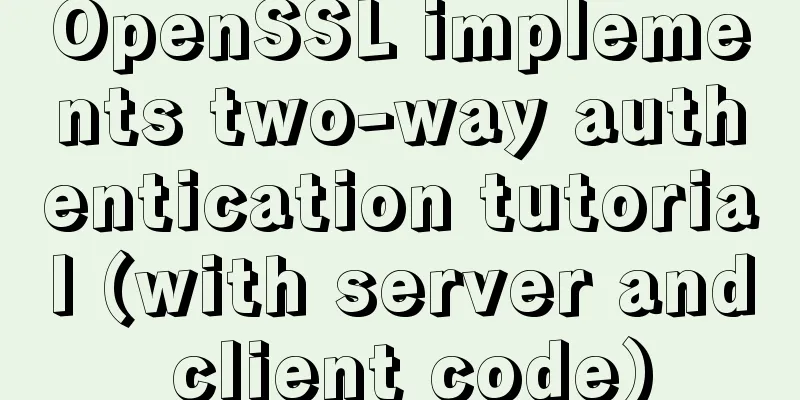OpenSSL implements two-way authentication tutorial (with server and client code)

|
1. Background 1.1 Problems A recent product testing report recommended the use of a PKI-based authentication method. Since the product has implemented HTTPS, we discussed and believed that it meant the use of two-way authentication to handle man-in-the-middle attacks. I have come across two-way authentication in the course "Information Security Engineering", but there are two problems. The first was that the final course design client was a browser, and the server was Tomcat. Two-way authentication only required configuration of both and did not require actual implementation of the code. The second is that although the course also has implementation code close to two-way authentication, it was in the Java+JCE environment at the time and now it has to use the C+++OpenSSL environment. The overall meaning is indeed similar, but there are still many differences in specific functions and parameters. So what we have now is: the idea of certificate generation + the idea of implementing two-way authentication. For readers, it is assumed that they have a basic understanding of several concepts such as certificates, SSL/TSL, socket programming, etc., which will not be introduced in detail in this article. Based on this, the problem to be solved in this article is: how does openssl generate certificates specifically + how does openssl implement two-way authentication. The key points of two-way authentication are the following functions (the same for both the server and the client). For the rest, please refer to the code comments: SSL_CTX_set_verify----Configure to enable two-way authentication SSL_CTX_load_verify_locations - Load trusted root certificates SSL_CTX_use_certificate_file----Load your own certificate SSL_CTX_use_PrivateKey_file----Load your own private key SSL_get_verify_result----To really verify, you must call this function, otherwise the previous four functions are just configurations and will not perform two-way verification. 2. Implementation of Bidirectional Authentication Procedure 2.1 Install openssl and develop api apt-get install libssl-dev 2.2 Server code
#include <stdio.h>
#include <stdlib.h>
#include <errno.h>
#include <string.h>
#include <sys/types.h>
#include <netinet/in.h>
#include <sys/socket.h>
#include <sys/wait.h>
#include <unistd.h>
#include <arpa/inet.h>
#include <openssl/ssl.h>
#include <openssl/err.h>
#define MAXBUF 1024
void ShowCerts(SSL * ssl)
{
X509 *cert;
char *line;
cert = SSL_get_peer_certificate(ssl);
// SSL_get_verify_result() is the key point. SSL_CTX_set_verify() only configures whether to enable it and does not perform authentication. Calling this function will actually verify the certificate authentication. // If the verification fails, the program throws an exception to terminate the connection if (SSL_get_verify_result (ssl) == X509_V_OK) {
printf("Certificate verification passed\n");
}
if (cert != NULL) {
printf("Digital certificate information:\n");
line = X509_NAME_oneline(X509_get_subject_name(cert), 0, 0);
printf("Certificate: %s\n", line);
free(line);
line = X509_NAME_oneline(X509_get_issuer_name(cert), 0, 0);
printf("Issuer: %s\n", line);
free(line);
X509_free(cert);
} else
printf("No certificate information!\n");
}
int main(int argc, char **argv) {
int sockfd, new_fd;
socklen_t len;
struct sockaddr_in my_addr, their_addr;
unsigned int myport, lisnum;
char buf[MAXBUF + 1];
SSL_CTX *ctx;
if (argv[1])
myport = atoi(argv[1]);
else
myport = 7838;
if (argv[2])
lisnum = atoi(argv[2]);
else
lisnum = 2;
/* SSL library initialization */
SSL_library_init();
/* Load all SSL algorithms */
OpenSSL_add_all_algorithms();
/* Load all SSL error messages */
SSL_load_error_strings();
/* Generate a SSL_CTX, SSL Content Text, in a way that is compatible with SSL V2 and V3 standards */
ctx = SSL_CTX_new(SSLv23_server_method());
/* You can also use SSLv2_server_method() or SSLv3_server_method() to indicate V2 or V3 standards separately*/
if (ctx == NULL) {
ERR_print_errors_fp(stdout);
exit(1);
}
// Two-way verification // SSL_VERIFY_PEER --- requires certificate authentication, and will allow the request to pass even if no certificate is present // SSL_VERIFY_FAIL_IF_NO_PEER_CERT --- requires the client to provide a certificate, but will allow the request to pass even if no certificate is present SSL_CTX_set_verify(ctx, SSL_VERIFY_PEER|SSL_VERIFY_FAIL_IF_NO_PEER_CERT, NULL);
// Set up the trusted root certificate if (SSL_CTX_load_verify_locations(ctx, "ca.crt",NULL)<=0){
ERR_print_errors_fp(stdout);
exit(1);
}
/* Load the user's digital certificate, which is used to send to the client. The certificate contains the public key*/
if (SSL_CTX_use_certificate_file(ctx, argv[3], SSL_FILETYPE_PEM) <= 0) {
ERR_print_errors_fp(stdout);
exit(1);
}
/* Load user private key */
if (SSL_CTX_use_PrivateKey_file(ctx, argv[4], SSL_FILETYPE_PEM) <= 0) {
ERR_print_errors_fp(stdout);
exit(1);
}
/* Check if the user's private key is correct*/
if (!SSL_CTX_check_private_key(ctx)) {
ERR_print_errors_fp(stdout);
exit(1);
}
/* Open a socket listener */
if ((sockfd = socket(PF_INET, SOCK_STREAM, 0)) == -1) {
perror("socket");
exit(1);
} else
printf("socket created\n");
bzero(&my_addr, sizeof(my_addr));
my_addr.sin_family = PF_INET;
my_addr.sin_port = htons(myport);
my_addr.sin_addr.s_addr = INADDR_ANY;
if (bind(sockfd, (struct sockaddr *) &my_addr, sizeof(struct sockaddr))
== -1) {
perror("bind");
exit(1);
} else
printf("binded\n");
if (listen(sockfd, lisnum) == -1) {
perror("listen");
exit(1);
} else
printf("begin listen\n");
while (1) {
SSL *ssl;
len = sizeof(struct sockaddr);
/* Waiting for the client to connect*/
if ((new_fd = accept(sockfd, (struct sockaddr *) &their_addr, &len))
== -1) {
perror("accept");
exit(errno);
} else
printf("server: got connection from %s, port %d, socket %d\n",
inet_ntoa(their_addr.sin_addr), ntohs(their_addr.sin_port),
new_fd);
/* Generate a new SSL based on ctx */
ssl = SSL_new(ctx);
/* Add the connected user's socket to SSL */
SSL_set_fd(ssl, new_fd);
/* Establish SSL connection */
if (SSL_accept(ssl) == -1) {
perror("accept");
close(new_fd);
break;
}
ShowCerts(ssl);
/* Start processing data sending and receiving on each new connection*/
bzero(buf, MAXBUF + 1);
strcpy(buf, "server->client");
/* Send message to client */
len = SSL_write(ssl, buf, strlen(buf));
if (len <= 0) {
printf("Message '%s' failed to send! Error code is %d, error message is '%s'\n", buf, errno,
strerror(errno));
goto finish;
} else
printf("Message '%s' was sent successfully, a total of %d bytes were sent!\n", buf, len);
bzero(buf, MAXBUF + 1);
/* Receive messages from the client */
len = SSL_read(ssl, buf, MAXBUF);
if (len > 0)
printf("Successful message reception: '%s', %d bytes of data\n", buf, len);
else
printf("Message reception failed! Error code is %d, error message is '%s'\n",
errno, strerror(errno));
/* Handle the end of data sending and receiving on each new connection*/
finish:
/* Close the SSL connection */
SSL_shutdown(ssl);
/* Release SSL */
SSL_free(ssl);
/* Close the socket */
close(new_fd);
}
/* Close the listening socket */
close(sockfd);
/* Release CTX */
SSL_CTX_free(ctx);
return 0;
}2.3 Client Code
#include <stdio.h>
#include <string.h>
#include <errno.h>
#include <sys/socket.h>
#include <resolv.h>
#include <stdlib.h>
#include <netinet/in.h>
#include <arpa/inet.h>
#include <unistd.h>
#include <openssl/ssl.h>
#include <openssl/err.h>
#define MAXBUF 1024
void ShowCerts(SSL * ssl)
{
X509 *cert;
char *line;
cert = SSL_get_peer_certificate(ssl);
// SSL_get_verify_result() is the key point. SSL_CTX_set_verify() only configures whether to enable it and does not perform authentication. Calling this function will actually verify the certificate authentication. // If the verification fails, the program throws an exception to terminate the connection if (SSL_get_verify_result (ssl) == X509_V_OK) {
printf("Certificate verification passed\n");
}
if (cert != NULL) {
printf("Digital certificate information:\n");
line = X509_NAME_oneline(X509_get_subject_name(cert), 0, 0);
printf("Certificate: %s\n", line);
free(line);
line = X509_NAME_oneline(X509_get_issuer_name(cert), 0, 0);
printf("Issuer: %s\n", line);
free(line);
X509_free(cert);
} else
printf("No certificate information!\n");
}
int main(int argc, char **argv)
{
int sockfd, len;
struct sockaddr_in dest;
char buffer[MAXBUF + 1];
SSL_CTX *ctx;
SSL *ssl;
if (argc != 5) {
printf("Parameter format error! Correct usage is as follows:\n\t\t%s IP address port\n\tFor example:\t%s 127.0.0.1 80\nThis program is used to get from a certain"
"The server at IP address receives messages with at most MAXBUF bytes at a certain port",
argv[0], argv[0]);
exit(0);
}
/* SSL library initialization, see ssl-server.c code*/
SSL_library_init();
OpenSSL_add_all_algorithms();
SSL_load_error_strings();
ctx = SSL_CTX_new(SSLv23_client_method());
if (ctx == NULL) {
ERR_print_errors_fp(stdout);
exit(1);
}
// Two-way verification // SSL_VERIFY_PEER --- requires certificate authentication, and will allow the request to pass even if no certificate is present // SSL_VERIFY_FAIL_IF_NO_PEER_CERT --- requires the client to provide a certificate, but will allow the request to pass even if no certificate is present SSL_CTX_set_verify(ctx, SSL_VERIFY_PEER|SSL_VERIFY_FAIL_IF_NO_PEER_CERT, NULL);
// Set up the trusted root certificate if (SSL_CTX_load_verify_locations(ctx, "ca.crt",NULL)<=0){
ERR_print_errors_fp(stdout);
exit(1);
}
/* Load the user's digital certificate, which is used to send to the client. The certificate contains the public key*/
if (SSL_CTX_use_certificate_file(ctx, argv[3], SSL_FILETYPE_PEM) <= 0) {
ERR_print_errors_fp(stdout);
exit(1);
}
/* Load user private key */
if (SSL_CTX_use_PrivateKey_file(ctx, argv[4], SSL_FILETYPE_PEM) <= 0) {
ERR_print_errors_fp(stdout);
exit(1);
}
/* Check if the user's private key is correct*/
if (!SSL_CTX_check_private_key(ctx)) {
ERR_print_errors_fp(stdout);
exit(1);
}
/* Create a socket for TCP communication */
if ((sockfd = socket(AF_INET, SOCK_STREAM, 0)) < 0) {
perror("Socket");
exit(errno);
}
printf("socket created\n");
/* Initialize the server (other party) address and port information*/
bzero(&dest, sizeof(dest));
dest.sin_family = AF_INET;
dest.sin_port = htons(atoi(argv[2]));
if (inet_aton(argv[1], (struct in_addr *) &dest.sin_addr.s_addr) == 0) {
perror(argv[1]);
exit(errno);
}
printf("address created\n");
/* Connect to server */
if (connect(sockfd, (struct sockaddr *) &dest, sizeof(dest)) != 0) {
perror("Connect ");
exit(errno);
}
printf("server connected\n");
/* Generate a new SSL based on ctx */
ssl = SSL_new(ctx);
SSL_set_fd(ssl, sockfd);
/* Establish SSL connection */
if (SSL_connect(ssl) == -1)
ERR_print_errors_fp(stderr);
else {
printf("Connected with %s encryption\n", SSL_get_cipher(ssl));
ShowCerts(ssl);
}
/* Receive the message sent by the other party, and receive at most MAXBUF bytes*/
bzero(buffer, MAXBUF + 1);
/* Receive messages from the server */
len = SSL_read(ssl, buffer, MAXBUF);
if (len > 0)
printf("Received message successfully: '%s', total %d bytes of data\n",
buffer,len);
else {
printf
("Message reception failed! Error code is %d, error message is '%s'\n",
errno, strerror(errno));
goto finish;
}
bzero(buffer, MAXBUF + 1);
strcpy(buffer, "from client->server");
/* Send a message to the server */
len = SSL_write(ssl, buffer, strlen(buffer));
if (len < 0)
printf
("Message '%s' failed to send! Error code is %d, error message is '%s'\n",
buffer, errno, strerror(errno));
else
printf("Message '%s' was sent successfully, a total of %d bytes were sent!\n",
buffer,len);
finish:
/* Close the connection */
SSL_shutdown(ssl);
SSL_free(ssl);
close(sockfd);
SSL_CTX_free(ctx);
return 0;
}2.4 Certificate Generation Pay attention to three points First, pay attention to changing the private key encryption password (-passout parameter) to your own password; the following steps all generate private keys with the -passout parameter. If you use the -nodes parameter, the last step "Convert the encrypted RSA key to an unencrypted RSA key" does not need to be executed. Second, certificates and keys are given in two forms: direct one-step generation and step-by-step generation. The two forms are equivalent. Here we use the direct generation form (the step-by-step generation form is commented) Third, be sure to change the certificate information to your own organization information. The meanings of the parameters of the certificate number are as follows: C-----Country Name ST----State or Province Name L----City (Locality Name) O----Company (Organization Name) OU----Department (Organizational Unit Name) CN----Common Name emailAddress----Email Address # CA certificate and key generation method 1 - directly generate CA key and self-signed certificate # If you do not need to enter a password when reading the private key file ca_rsa_private.pem in the future, that is, do not encrypt the private key for storage, then replace -passout pass:123456 with -nodes openssl req -newkey rsa:2048 -passout pass:123456 -keyout ca_rsa_private.pem -x509 -days 365 -out ca.crt -subj "/C=CN/ST=GD/L=SZ/O=COM/OU=NSP/CN=CA/[email protected]" # CA certificate and key generation method 2 -- Generate CA key and self-signed certificate step by step: # openssl genrsa -aes256 -passout pass:123456 -out ca_rsa_private.pem 2048 # openssl req -new -x509 -days 365 -key ca_rsa_private.pem -passin pass:123456 -out ca.crt -subj "/C=CN/ST=GD/L=SZ/O=COM/OU=NSP/CN=CA/[email protected]" # Server certificate and key generation method 1 - directly generate server key and certificate to be signed # If you do not need to enter a password when reading the private key file server_rsa_private.pem in the future, that is, do not encrypt and store the private key, then replace -passout pass:server with -nodes openssl req -newkey rsa:2048 -passout pass:server -keyout server_rsa_private.pem -out server.csr -subj "/C=CN/ST=GD/L=SZ/O=COM/OU=NSP/CN=SERVER/[email protected]" # Server certificate and key generation method 2 -- Generate server key and certificate to be signed step by step# openssl genrsa -aes256 -passout pass:server -out server_rsa_private.pem 2048 # openssl req -new -key server_rsa_private.pem -passin pass:server -out server.csr -subj "/C=CN/ST=GD/L=SZ/O=COM/OU=NSP/CN=SERVER/[email protected]" # Use the CA certificate and key to sign the server certificate: openssl x509 -req -days 365 -in server.csr -CA ca.crt -CAkey ca_rsa_private.pem -passin pass:123456 -CAcreateserial -out server.crt # Convert the encrypted RSA key to an unencrypted RSA key to avoid requiring the decryption password every time it is read. # The password is the passout set when generating the private key file and the passin to be entered when reading the private key file. For example, enter "server" here. openssl rsa -in server_rsa_private.pem -out server_rsa_private.pem.unsecure # Method 1 for generating client certificate and key: directly generate client key and certificate to be signed # If you do not need to enter a password when reading the private key file client_rsa_private.pem in the future, that is, do not encrypt and store the private key, then replace -passout pass:client with -nodes openssl req -newkey rsa:2048 -passout pass:client -keyout client_rsa_private.pem -out client.csr -subj "/C=CN/ST=GD/L=SZ/O=COM/OU=NSP/CN=CLIENT/[email protected]" # Method 2 for generating client certificate and key: Generate client key and certificate to be signed step by step: # openssl genrsa -aes256 -passout pass:client -out client_rsa_private.pem 2048 # openssl req -new -key client_rsa_private.pem -passin pass:client -out client.csr -subj "/C=CN/ST=GD/L=SZ/O=COM/OU=NSP/CN=CLIENT/[email protected]" # Use the CA certificate and key to sign the client certificate: openssl x509 -req -days 365 -in client.csr -CA ca.crt -CAkey ca_rsa_private.pem -passin pass:123456 -CAcreateserial -out client.crt # Convert the encrypted RSA key to an unencrypted RSA key to avoid requiring the decryption password every time it is read. # The password is the passout set when generating the private key file and the passin to be entered when reading the private key file. For example, enter "client" here. openssl rsa -in client_rsa_private.pem -out client_rsa_private.pem.unsecure 2.5 Development environment configuration Operating system----kali-roaling. It's just for the purpose of using the current virtual machine. There should be no difference in using Ubuntu, CentOS, etc. IDE----eclipse. If the compilation fails directly in the terminal, I will not investigate further. If there is no problem compiling in Eclipse, I will just use Eclipse. 2.5.1 Create two projects in the same active directory myclient1----Create a src folder to put the client code myserver1----Create a src folder to store the server code (Other directories are either automatically generated or automatically generated after compilation, so don't worry about them; if the project reports an error, try restarting eclipse or even the operating system several times)
2.5.2 Specifying SSL and Crypto Right click on the project folder ---- Properties ---- specify the ssl library and crypto library directories, otherwise the compilation cannot find ssl. Both projects need to be configured
2.5.3 Compilation Use the Ctrl+B shortcut key to compile, eclipse will compile all projects 2.5.4 Certificate Copy Copy the previously generated ca certificate (ca.crt), client certificate (client.crt), and client unencrypted private key file () to the Debug directory of the myclient1 project Copy the previously generated CA certificate, server certificate, and server-side unencrypted private key files to the Debug directory of the myclient1 project 2.5.5 Run the program Run the server first and then the client
The operation results are as follows, server:
Client:
The above is the full content of this article. I hope it will be helpful for everyone’s study. I also hope that everyone will support 123WORDPRESS.COM. You may also be interested in:
|
<<: Example analysis of interval calculation of mysql date and time
>>: JavaScript knowledge: Constructors are also functions
Recommend
How to use vite to build vue3 application
1. Installation Tip: There is currently no offici...
The way to represent colors in HTML is by using 6-digit hexadecimal codes, RGB or keywords.
There are three ways to represent colors in HTML, ...
HTML+CSS+JavaScript realizes the display of selected effect following the mouse movement
1. Display effect: 2, html structure <div clas...
10 Website Usability Tips Everyone Should Know
Let’s not waste any more time and get straight to...
Docker builds Redis5.0 and mounts data
Table of contents 1. Simple mounting of persisten...
Detailed explanation of Dockerfile to create a custom Docker image and comparison of CMD and ENTRYPOINT instructions
1. Overview There are three ways to create a Dock...
Implementation of Vue counter
Table of contents 1. Implementation of counter 2....
A thorough understanding of js native syntax prototype, __proto__ and constructor
Table of contents 1 Introduction 2 Prerequisites ...
How to insert pictures into HTML pages and add map index examples
1. Image formats supported on the WEB: GIF: can s...
How to build sonarqube using docker
Table of contents 1. Install Docker 2. Install so...
What are the file attributes of crw, brw, lrw, etc. in Linux?
What is a file? All files are actually a string o...
WeChat applet uses the video player video component
This article example shares the specific code of ...
CSS shadow animation optimization tips
This technique comes from this article - How to a...
Use of vuex namespace
Table of contents Since Vuex uses a single state ...
How to connect JDBC to MySQL 5.7
1. First prepare the MySQL and Eclipse environmen...













